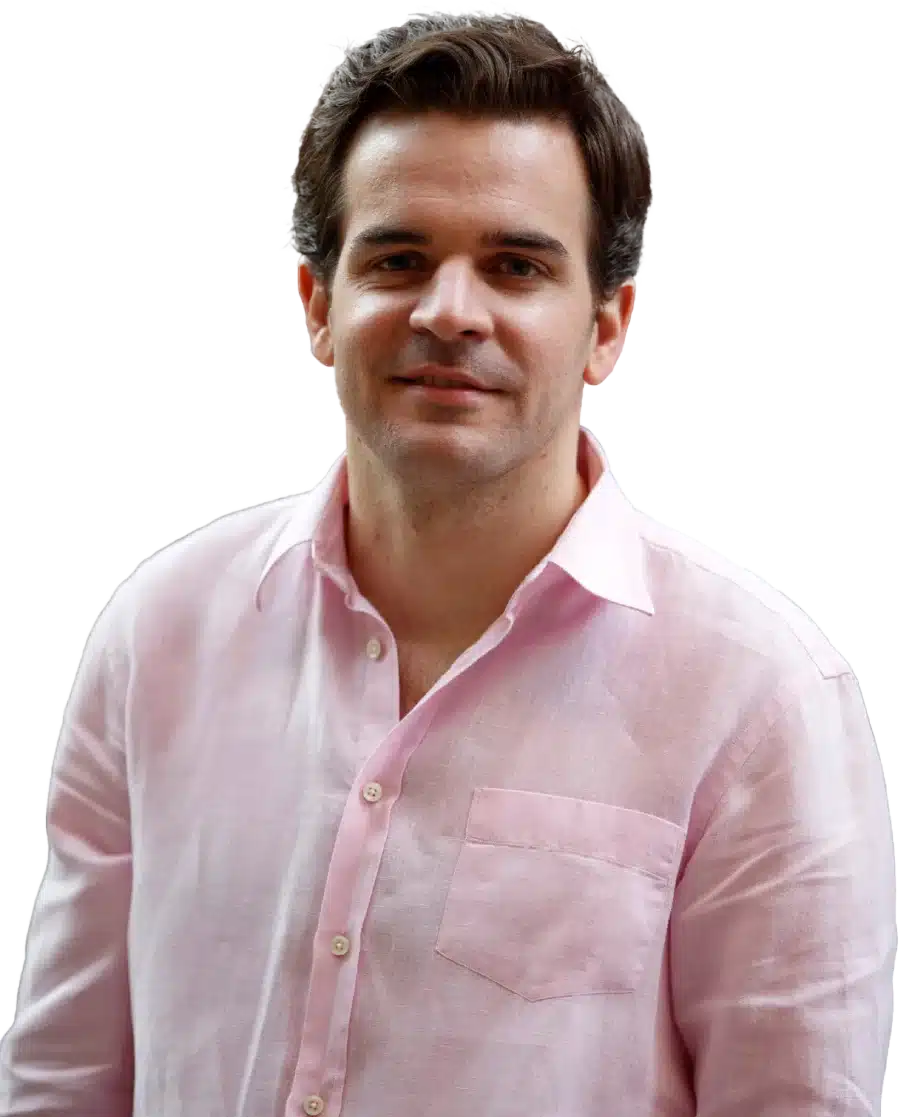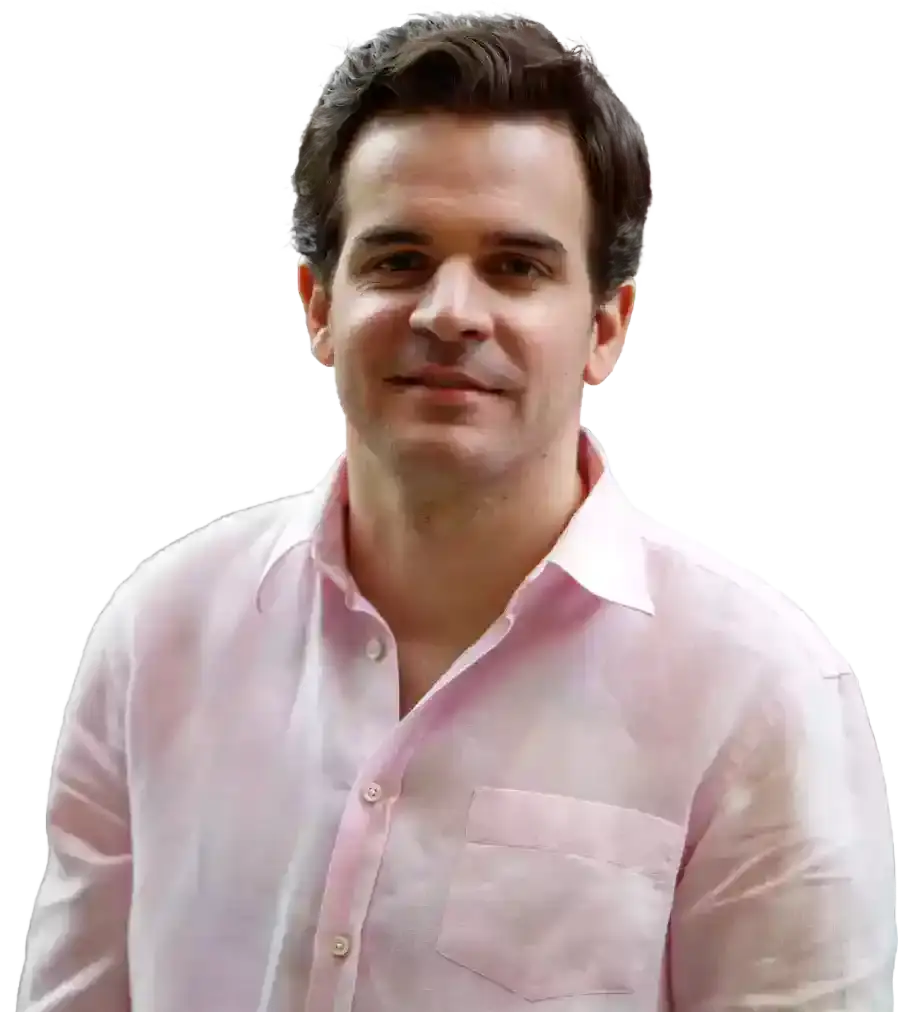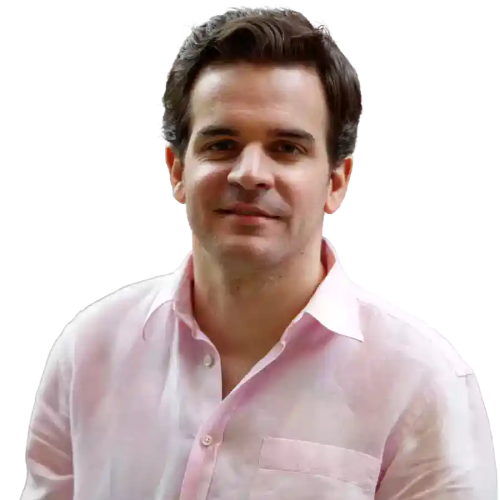David Young’s journey to becoming a tech entrepreneur is anything but conventional. His career path took him from studying ancient Greek at Indiana University to Wall Street, and eventually to Silicon Valley, where he founded and scaled successful technology startups, including Joyent.
This post dives deep into David’s experiences, from early failures to high-impact successes, and the lessons learned along the way.
Listen to the full podcast episode and review the transcript here.

*FREE DOWNLOAD*
The Ultimate Guide To Pitch Decks
From Classics to Capital Markets
Born and raised in Dallas, Texas, David grew up in an environment fostering exploration and ambition. At first glance, a degree in ancient Greek may not seem like the most direct path to a career in tech.
However, for David, his classical studies provided a deep foundation in analytical thinking, structured problem-solving, and the ability to understand and synthesize complex ideas—skills that would later serve him well in the startup world.
In David’s perspective, one of the key factors missing in our technological culture is a lack of understanding and depth of knowledge that people in the ancient world possessed. The best way to come into contact with this knowledge is to learn the language.
David did an intensive study of Greek and Latin, including the works of Pindar, a Greek poet. This learning proved to be a robust basis for picking up the principles of software engineering, which became easy despite the hard work involved.
After college at Indiana University, David considered pursuing a Ph.D. in classics but was advised to explore other career options due to the limited financial prospects in academia. That advice led him to Wall Street, where he was recruited into a bank.
Here, David was first introduced to the intersection of finance and technology. At the time, Wall Street was aggressively investing in technology as a way to gain a competitive edge.
David observed firsthand how firms like Goldman Sachs were leveraging new computing systems, including Steve Jobs’ NeXT Computer, to transform trading practices and differentiate their businesses. He quickly became a part of the culture.
Despite gaining valuable experience, David soon realized that the structured environment of a large financial institution was not where his entrepreneurial spirit could thrive.
A Leap into Tech Startups
David made the bold decision to leave the finance world and move to the West Coast to enter the tech startup scene. His first venture, manageStar, was a SaaS company aimed at the construction and task management industries.
Though the startup grew to around 100 employees and had a great founding team, it ultimately failed to gain long-term traction. This experience, however, was a crucial learning opportunity for David who served as the CTO.
Failure, David believes, is a necessary part of the entrepreneurial process. manageStar taught him the importance of market timing, customer needs, and the operational challenges of scaling a business. It was in the wake of this failure that the idea for Joyent was born.

Raise Capital Smarter, Not Harder
- AI Investor Matching: Get instantly connected with the right investors
- Pitch & Financial Model Tools: Sharpen your story with battle-tested frameworks
- Proven Results: Founders are closing 3× faster using StartupFundraising.com
Building Joyent: A Cloud Revolution
Before the AWS and Google Cloud era, setting up the infrastructure for a tech startup was complex and cumbersome. Companies had to purchase physical servers and high-end, expensive databases, and employ teams to manage their data centers.
David saw an opportunity to change this by creating an infrastructure-as-a-service platform that was unheard of but would later become known as cloud computing. At that time, he called it a data center on demand or a data center as a service platform.
Joyent was founded with the vision of providing businesses with on-demand access to computing power and storage. The initial reception was skeptical—many companies were hesitant to move away from their traditional on-premise infrastructure.
However, Joyent found its breakthrough by partnering with the Web 2.0 movement, which was driven by startups that needed flexible, scalable solutions to power their growing platforms. These entrepreneurs wanted ways to quickly create these user-generated content-based services.
Early adopters included major names like Twitter, Tumblr, and Facebook’s developer program. By being at the right place at the right time, Joyent established itself as a pioneer in the cloud computing space, ultimately leading to its acquisition by Samsung.
The Transition from CTO to CEO
David’s first startup role was primarily technical, serving as the CTO. But with Joyent, he stepped into the CEO position on the business side of things, which required a completely different skill set.
David found that while he loved the product development process, scaling a company from a small team to over 500 employees introduced a new set of challenges. One of the most significant lessons he learned was managing rapid growth.
In the early days, a startup team operates like a close-knit family, but maintaining a strong culture and clear communication becomes increasingly difficult as the company scales.
David recalls moments when he would walk into the office and realize he no longer knew every employee by name—a stark contrast from the early days when the entire team could gather around a dinner table.
Another challenge was maintaining personal well-being. The pressures of leading a fast-growing startup led to struggles with work-life balance and unhealthy coping mechanisms.
However, having a strong support system and honest conversations about his challenges with his team, colleagues, and investors helped David navigate them. He strived to be as perfect as he could.
Raising $120M: The Art of Fundraising
Throughout Joyent’s journey, David and his team raised over $120M in funding. Fundraising, he explains, is not just about selling a vision to investors—it’s about being transparent about both the opportunities and the challenges a company faces.
One key to Joyent’s fundraising success was the partnership between David and Brian Brown, a former Wall Street Journal writer who became integral to the company’s corporate development efforts. David remembers him as a great writer and communicator.
Together, the duo crafted a compelling narrative that communicated the potential of Joyent’s technology while being upfront about the hurdles they needed to overcome. They educated investors about their vision for the company, and the areas where they had success.
Storytelling is everything that David Young was able to master. The key is capturing the essence of what you are doing in 15 to 20 slides. For a winning deck, take a look at the pitch deck template created by Silicon Valley legend, Peter Thiel (see it here) where the most critical slides are highlighted.
Remember to unlock the pitch deck template that founders worldwide are using to raise millions below.
David emphasizes the importance of finding a “Brian”—someone who can serve as a strategic sounding board, ensuring that the messaging is both ambitious and realistic.
He advises entrepreneurs to focus on clarity and honesty in their pitches, as investors appreciate founders with a strong grasp of their business’s strengths and weaknesses. This strategy also works well for colleagues and customers since it helps founders build better products.
David concedes that entrepreneurs are often self-deceptive. They have these sales projections of where they want their products to be, when the products may or may not make that progress. He advises entrepreneurs to always maintain a positive outlook and focus on overcoming hurdles.
Honeymoon Brands – The Next Venture
As David recalls, they had phenomenal success with Joyent. Although competitors like Amazon and Google Cloud continued to innovate, most of their ideas like microservices and containers have their basis in Joyent.
After the acquisition, David was ready to explore a new line absolutely different from software and hardware. That’s when he came up with the idea to start an ice cream company. At that time, he lived in Marin County, just north of San Francisco.
David picked up the culture for dairy and fine cheese, and developed an idea for amazing ice cream flavors in glass containers. He ended up building Honeymoon Brands, which received rave reviews in the Savoir magazine.
David successfully managed product development, creating ice cream, candies, and jams. However, he and his partner had trouble executing the supply chain, distribution, and other facets. Eventually, they sold the company.
Building Federated Computer
After the acquisition, David was ready to take on his next project. During the COVID pandemic, he noticed that privacy was a big concern.
People disliked that their data, which was a part of SaaS companies, like Google Workplace, Zoom, or Slack, was being disseminated for advertising purposes. Next came training AI or artificial intelligence. David started exploring open source tools like Nextcloud, Jitsi, and Baserow.
However, he quickly realized that to adopt them, a business required an on-site IT professional to keep it running, add patches, and do the integrations–a complicated process. David partnered with his past collaborators and created a Linux distribution in the cloud.
They grabbed a bunch of different packages and integrated them to make it easy to manage users. They also did the updates and backups so users got the experience of a great SaaS software, but without the cost and with the privacy and flexibility.
David explains that users can fully differentiate their businesses by leveraging open source tools. That’s where Federated Computers comes in–a platform that makes it super simple for users to adopt these tools.
A Disruptive Approach to SaaS Pricing
David also introduced a revolutionary approach to SaaS pricing. Traditional SaaS customers often pay between $300 to $400 per user per month for various software solutions.
Federated Computer offers a comprehensive package that includes video conferencing for up to 500 users, workplace tools, databases, mailing lists, and everything a business needs to operate—all for just $120 per month, with even more affordable tiers available.
David emphasizes that this model is not only cost-effective but also completely private and highly flexible. He draws parallels between this disruptive pricing structure and the early days of cloud computing, where the upfront costs of setting up a data center were significantly reduced.
Federated Computer eliminates the need for businesses to spend large sums on disparate SaaS solutions that often lack seamless integration.
By consolidating these services into one affordable package, businesses can allocate their financial resources to more strategic initiatives such as hiring employees or investing in marketing efforts.
David believes this model presents a tremendous opportunity for businesses looking for efficiency and cost savings.
The Future of Federated Computer and Open-Source Innovation
Looking ahead, David envisions a world where Federated Computer’s open-source model leads to the emergence of multiple federated computing providers. He welcomes this evolution, much like how cloud computing expanded beyond its early pioneers.
Federated Computer is already servicing and supporting thousands of customers worldwide, and David sees this as just the beginning.
He remains committed to expanding the company’s reach, continuing to introduce its offerings to new customers who appreciate the affordability, value, and flexibility the platform provides.
Lessons from an Entrepreneurial Journey
Reflecting on his career, David acknowledges that while he has made mistakes, he has few regrets. His key piece of advice to aspiring entrepreneurs is to remain persistent in trying new things.
The uncertainty and anxiety that come with entrepreneurship are inevitable, but success often lies in trusting the team, believing in the vision, and maintaining resilience. One additional lesson David shares is the importance of taking breaks.
In the fast-paced world of startups, postponing vacations and pushing through exhaustion is easy. However, David has learned that burnout is unsustainable. Taking time off to recharge ultimately enhances productivity and strengthens the ability to tackle challenges with renewed energy.
His message to fellow entrepreneurs is clear: take the vacation, refresh, and then return to the fight with vigor and determination.
Final Thoughts
David Young’s story is a testament to entrepreneurship’s unpredictable yet rewarding nature. From studying ancient civilizations to building one of the early cloud computing companies, his path has been anything but linear.
Yet, David has left a lasting impact on the tech industry through persistence, adaptability, and a commitment to learning.
For those looking to embark on their own entrepreneurial journey, his story inspires them to embrace the unconventional, learn from failure, and build with vision and resilience.
Listen to the full podcast episode to know more, including:
- David’s journey from studying ancient Greek to tech entrepreneurship highlights the value of analytical thinking and problem-solving across disciplines.
- His early startup, manageStar, didn’t succeed, but it taught him critical lessons that helped shape Joyent’s success in cloud computing.
- Joyent’s breakthrough came by aligning with the Web 2.0 movement, proving that market timing and strategic partnerships are crucial for scaling a startup.
- Transitioning from CTO to CEO, David learned that scaling a company requires different skills, including communication, culture-building, and managing rapid expansion.
- Raising $120M for Joyent was not just about pitching a vision but also about transparency and finding a great communicator to craft compelling narratives.
- From cloud computing to ice cream and now Federated Computer, David continues to explore new industries, proving that adaptability and innovation drive long-term success.
- While resilience is key, David emphasizes the importance of recharging to sustain long-term productivity and creativity in entrepreneurship.
SUBSCRIBE ON:
Keep in mind that storytelling is everything in fundraising. In this regard, for a winning pitch deck to help you, take a look at the template created by Peter Thiel, the Silicon Valley legend (see it here), which I recently covered. Thiel was the first angel investor in Facebook with a $500K check that turned into more than $1 billion in cash.
*FREE DOWNLOAD*
The Ultimate Guide To Pitch Decks
Remember to unlock for free the pitch deck template that founders worldwide are using to raise millions below.
Podcast: Play in new window | Download
Subscribe: Apple Podcasts | Spotify | TuneIn | RSS | More





Facebook Comments